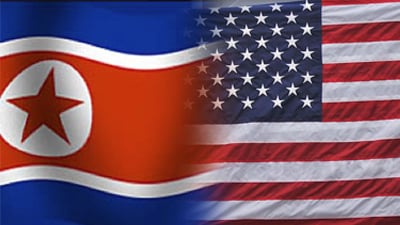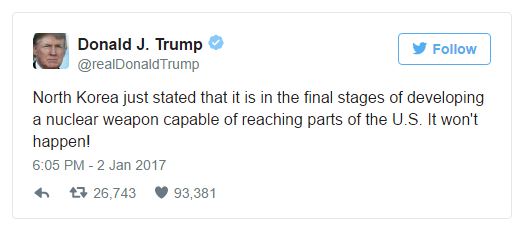US Contemplates Attack against North Korea

According to a The Wall Street Journal’s report, the US administration contemplates a military first strike against North Korea should that country come close to testing an intercontinental ballistic missile (ICBM) capable of delivering a nuclear warhead against the continental United States. US officials have underscored the possible military dimensions of their emerging strategy in recent discussions with allies, suggesting that the planning is at an advanced stage.

During a Senate Armed Services Committee hearing in December, Sen. Lindsey Graham revealed that said he intended to introduce an authorization for the use of military force to provide the president with the statutory approval to preemptively stop Pyongyang from finishing the development of its ICBM.
During a speech at the beginning of this year, Kim Jong Un claimed his country was prepared to begin testing intercontinental ballistic missiles that had the potential to reach the United States. Then-President-elect Trump took to Twitter to state the tests would not be happening. He did not elaborate but a military solution is what comes to mind.
North Korea has been testing ballistic missiles for the past few years, stepping up the frequency recently. In 2016, North Korea performed two nuclear tests and several missile launches to spark international outrage. Many arms control specialists believe that, by 2020, North Korea could have the capacity to launch a miniaturized nuclear device on an ICBM, with the range to strike at least the West Coast. It might even have that capacity sooner.
Last February, North Korea launched a satellite into space, which was widely seen as a test of long-range ballistic missile technology. The test suggested that North Korea was on the verge of developing a missile that could carry a 1,300-pound warhead some 7,000 miles. Pyongyang is believed to be capable of mounting a nuclear warhead on a ballistic missile but the capability to miniaturize a nuclear device has been questioned. Nor has it yet tested the missile’s re-entry capability needed to reach a specific target while withstanding extremes of temperature and vibration.
Tensions on the Korean peninsula have heightened recently, especially after Pyongyang performed a ballistic missile test on February 12 – the first one since US President Donald Trump took office. It was strongly condemned by the UN Security Council. Even China said that it would be suspending coal imports from North Korea for the rest of the year in response to the test. The country is highly dependent on China, which supplies it with most of its food and energy and accounts for more than 70 percent of North Korea’s total trade volume.
Amid heightened tensions over missile tests, the US and South Korean armed forces have launched a set of annual drills with several hundred thousand soldiers involved. The US would also employ aircraft carrier USS Carl Vinson, F-35 and the bombers B-1B and B-52 during the drills. US Defense Secretary James Mattis told his South Korean counterpart Han Min-koo the US «remains steadfast in its commitment» to South Korea’s defense. He warned that any North Korean attack on the US or its allies would be defeated and any use of nuclear weapons would be met with an «effective and overwhelming» response.
The exercise Foal Eagle will last for two months till April-end. The training event comes after Seoul claimed that Pyongyang plotted the alleged murder of Kim Jong-nam in Malaysia. North Korea has repeatedly condemned the drills as preparations for an attack.
On March 28, the South Korean government formalized the purchase of land for the installation of the Terminal High Altitude Area Defense (THAAD) system to be deployed this year. Last year, the US and South Korea agreed to build a missile defense system together. Both Russia and China have spoken out against THAAD, stating they will seek to intensify their opposition to the defense system. The Pentagon has more than 75,000 troops based in Japan and South Korea. South Korea hosts 28,000 of them.
No doubt, the US has the unexpected first strike capability can knock out the nuclear infrastructure using stealth aircraft and sea-based standoff cruise missiles. The aircraft could drop GBU-57 Massive Ordnance Penetrators to reach the targets located deep underground. Two Ohio-class cruise missile submarines with more than 300 BGM-109 missiles could be secretly deployed off the coast. The number of missiles would grow at least twice when surface ships approach North Korea. After nuclear sites are destroyed, key defense installations, including transporter erector launchers (TEL), and delivery vehicles will be hit.
The US could limit the use of force to the nuclear program only in hope to prevent de-escalation or it could conduct a large-scale operation to destroy the military potential and change the regime. In the latter case, the US forces in South Korea would become targets for a retaliatory strike in a full-scale war.
Large-scale deployment cannot be clandestine to make inevitable North Korean pre-emptive strikes, taking cover and dispersion of forces in preparation for a conflict of long duration.
There is one more scenario. The special unit known as the Korea Massive Punishment and Retaliation (KMPR) is to be mission-ready this year. It is created to decapitate North Korea by physically eliminating its leader Kim Jong Un. South Korea has already developed a plan to annihilate the North Korean capital of Pyongyang through intensive bombing in case the North shows any signs of a nuclear attack. Any campaign would employ surface-to-surface Hyunmoo 2A, 2B and Hyunmoo 3 ballistic missiles, which have ranges of 300 km (185 miles), 500 km (310 miles) and 1,000 km (620 miles), respectively, to pummel the North’s capital city.
A military plan should take into account North Korea’s capability to use chemical and biological weapons. Seoul, the capital of South Korea, is within easy artillery range. North and South Korea are still technically at war as they signed an armistice but not a treaty following the end of the Korean War in 1953.
If intermediate-range Musudan missiles are not knocked out at first strike, they can be used to hit targets as far as Japan and Guam. A conventional strike on North Korea would almost certainly escalate to war. Pyongyang has a 1.1 million-man army, including a mechanized infantry corps, an artillery corps, an armored corps, and several infantry corps. 13,000 artillery pieces deployed along the demilitarized zone, 30 miles from Seoul. It boasts around 1,100 tactical short-range and medium-range ballistic missiles, in addition to 100–200 intermediate range weapons (the Musudan).
Perhaps, a rapid, victorious military action is the best way to unite the US against the background as the ongoing internal struggle between pro-Trump and anti-Trump forces and a wave of scandals hitting media headlines. China is a hard nut to crack and an operation against Iran will entail grave implications. Among the nations unfriendly toward the US North Korea is best suited for the role.
There is another option – to revive the Six-Party talks to prevent Pyongyang from developing a nuclear-capable ICBM in exchange for a peace agreement. The US, Russia, China, Japan and South Korea, as well as other international heavyweights and pertinent actors, could join forces to give a new impulse to the negotiation process.
The US and China are critical players but the bilateral relationship has deteriorated, especially after Donald Trump took office. The two rivals appear to be on a collision course. Russia is in position to mediate and bring them together. The same applies to the tense situation in the South China Sea. The three powers could set the differences aside to speak with one voice on this specific issue as no one is interested in Pyongyang going nuclear. North Korea is another security problem that needs to be urgently addressed internationally before it is too late. It should also become part of Russia-US security agenda.
The original source of this article is Strategic Culture Foundation
Copyright © Alex Gorka, Strategic Culture Foundation, 2017
Copyright © Alex Gorka, Strategic Culture Foundation, 2017


No comments:
Post a Comment